Atomic features of an autoantigen in heparin-induced thrombocytopenia (HIT)
- PMID: 26970483
- PMCID: PMC4875785
- DOI: 10.1016/j.autrev.2016.03.011
Atomic features of an autoantigen in heparin-induced thrombocytopenia (HIT)
Abstract
Autoantigen development is poorly understood at the atomic level. Heparin-induced thrombocytopenia (HIT) is an autoimmune thrombotic disorder caused by antibodies to an antigen composed of platelet factor 4 (PF4) and heparin or cellular glycosaminoglycans (GAGs). In solution, PF4 exists as an equilibrium among monomers, dimers and tetramers. Structural studies of these interacting components helped delineate a multi-step process involved in the pathogenesis of HIT. First, heparin binds to the 'closed' end of the PF4 tetramer and stabilizes its conformation; exposing the 'open' end. Second, PF4 arrays along heparin/GAG chains, which approximate tetramers, form large antigenic complexes that enhance antibody avidity. Third, pathogenic HIT antibodies bind to the 'open' end of stabilized PF4 tetramers to form an IgG/PF4/heparin ternary immune complex and also to propagate the formation of 'ultralarge immune complexes' (ULCs) that contain multiple IgG antibodies. Fourth, ULCs signal through FcγRIIA receptors, activating platelets and monocytes directly and generating thrombin, which transactivates hematopoietic and endothelial cells. A non-pathogenic anti-PF4 antibody prevents tetramer formation, binding of pathogenic antibody, platelet activation and thrombosis, providing a new approach to manage HIT. An improved understanding of the pathogenesis of HIT may lead to novel diagnostics and therapeutics for this autoimmune disease.
Keywords: Autoimmunity; FcγRIIA; Heparin-induced thrombocytopenia; Immune complex structure; Pathogenesis.
Copyright © 2016 Elsevier B.V. All rights reserved.
Figures

References
-
- Arepally GM, Ortel TL. Clinical practice. Heparin-induced thrombocytopenia. N Engl J Med. 2006;355:809–17. - PubMed
-
- Arepally GM, Cines DB. Pathogenesis of heparin-induced thrombocytopenia and thrombosis. Autoimmun Rev. 2002;1:125–32. - PubMed
-
- Linkins L-A, Dans AL, Moores LK, Bona R, Davidson BL, Schulman S, Crowther M. Treatment and prevention of heparin-induced thrombocytopenia: antithrombotic therapy and prevention of thrombosis: American College of Chest Physicians evidence-based clinical practice guidelines. CHEST Journal. 2012;141:e495S–e530S. - PMC - PubMed
Publication types
MeSH terms
Substances
Grants and funding
LinkOut - more resources
Full Text Sources
Other Literature Sources
Medical
Miscellaneous

